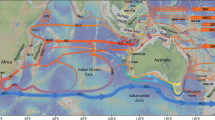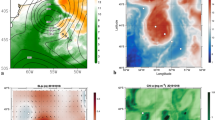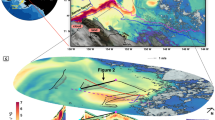Abstract
Approximately 10 million m3 s-1 of water flow from the Pacific Ocean into the Indian Ocean through the Indonesian seas1. Within the Makassar Strait, the primary pathway of the flow2, the Indonesian throughflow is far cooler than estimated earlier, as pointed out recently on the basis of ocean current and temperature measurements3,4. Here we analyse ocean current and stratification data along with satellite-derived wind measurements, and find that during the boreal winter monsoon, the wind drives buoyant, low-salinity Java Sea surface water into the southern Makassar Strait, creating a northward pressure gradient in the surface layer of the strait. This surface layer ‘freshwater plug’ inhibits the warm surface water from the Pacific Ocean from flowing southward into the Indian Ocean, leading to a cooler Indian Ocean sea surface5,6,7, which in turn may weaken the Asian monsoon8. The summer wind reversal eliminates the obstructing pressure gradient, by transferring more-saline Banda Sea surface water into the southern Makassar Strait. The coupling of the southeast Asian freshwater budget to the Pacific and Indian Ocean surface temperatures by the proposed mechanism may represent an important negative feedback within the climate system.
This is a preview of subscription content, access via your institution
Access options
Subscribe to this journal
Receive 51 print issues and online access
$199.00 per year
only $3.90 per issue
Buy this article
- Purchase on Springer Link
- Instant access to full article PDF
Prices may be subject to local taxes which are calculated during checkout




Similar content being viewed by others
References
Gordon, A. L. in Ocean Circulation and Climate: Observing and Modeling the Global Ocean (ed. Gould, J.) 303–314 (Academic, San Diego, 2001)
Gordon, A. L. & Fine, R. A. Pathways of water between the Pacific and Indian Oceans in the Indonesian seas. Nature 379, 146–149 (1996)
Ffield, A., Vranes, K., Gordon, A. L., Susanto, R. D. & Garzoli, S. L. Temperature variability within Makassar Strait. Geophys. Res. Lett. 27, 237–240 (2000)
Vranes, K., Gordon, A. L. & Ffield, A. The heat transport of the Indonesian Throughflow and implications for the Indian Ocean heat budget. Deep-Sea Res. II 49, 1391–1410 (2002)
Lee, T., Fukumori, I., Menemenlis, D., Xing, Z. & Fu, L. Effects of the Indonesian Throughflow on the Pacific and Indian Oceans. J. Phys. Oceanogr. 32, 1404–1429 (2002)
Hirst, A. C. & Godfrey, J. S. The role of Indonesian Throughflow in a global ocean GCM. J. Phys. Oceanogr. 23, 1057–1086 (1993)
Godfrey, S. The effect of the Indonesian Throughflow on ocean circulation and heat exchange with the atmosphere: A review. J. Geophys. Res. 101, 12217–12237 (1996)
Wajsowicz, R. Air-sea interaction over the Indian Ocean due to variations in the Indonesian Throughflow. Clim. Dyn. 18, 437–453 (2002)
Wajsowicz, R. & Schneider, E. K. The Indonesian throughflow's effect on global climate determined from the COLA coupled climate system. J. Clim. 14, 3029–3042 (2001)
Ilahude, A. G. & Gordon, A. L. Thermocline stratification within the Indonesian Seas. J. Geophys. Res. 101, 12401–12409 (1996)
Van Aken, H. M., Punjanan, J. & Saimima, S. Physical aspects of the flushing of the east Indonesian basins. Neth. J. Sea Res. 22, 315–339 (1988)
Piola, A. R. & Gordon, A. L. On oceanic heat and fresh-water fluxes at 30°S. J. Phys. Oceanogr. 16, 2184–2190 (1986)
Toole, J. M. & Warren, B. A. A hydrographic section across the subtropical South Indian Ocean. Deep-Sea Res. I 40, 1973–2019 (1993)
Robbins, P. E. & Toole, J. M. The dissolved silica budget as a constraint on the meridional overturning circulation of the Indian Ocean. Deep-Sea Res. I 44, 879–906 (1997)
Macdonald, A. M. Property fluxes at 30S and their implications for the Pacific-Indian throughflow and the global heat budget. J. Geophys. Res. 98, 6851–6868 (1993)
Ganachaud, A. & Wunsch, C. Improved estimates of global ocean circulation, heat transport and mixing from hydrographic data. Nature 408, 453–457 (2000)
Ganachaud, A. & Wunsch, C. Large-scale ocean heat and freshwater transports during the World Ocean Circulation Experiment. J. Clim. 16, 696–705 (2003)
Gordon, A. L., Susanto, R. D. & Ffield, A. Throughflow within Makassar Strait. Geophys. Res. Lett. 26, 3325–3328 (1999)
Molcard, R., Fieux, M. & Ilahude, A. G. The Indo-Pacific throughflow in the Timor Passage. J. Geophys. Res. 101, 12411–12420 (1996)
Molcard, R., Fieux, M. & Syamsudin, F. The throughflow within Ombai Strait. Deep-Sea Res. I 48, 1237–1253 (2001)
Murray, S. P. & Arief, D. Throughflow into the Indian Ocean through the Lombok Strait, January 1985–January 1986. Nature 333, 444–447 (1988)
Oberhuber, J. M. An Atlas Based on “COADS” Data Set (Tech. Rep. 15, Max-Planck-Institut für Meteorologie, Hamburg, 1988).
Wyrtki, K. Physical Oceanography of the Southeast Asian Waters (NAGA Rep. 2, Scripps Institution of Oceanography, La Jolla, 1961).
Mariano, A. J., Ryan, E. H., Perkins, B. D. & Smithers, S. The Mariano Global Surface Velocity Analysis 55 (United States Coast Guard, Washington DC, 1995)
Saji, N. H., Goswami, B. N., Vinayachandran, P. N. & Yamagata, T. A dipole mode on the tropical Indian Ocean. Nature 401, 360–363 (1999)
Susanto, R. D., Gordon, A. L. & Zheng, Q. N. Upwelling along the coasts of Java and Sumatra and its relation to ENSO. Geophys. Res. Lett. 28, 1599–1602 (2001)
Schneider, N. The Indonesian throughflow and the global climate system. J. Clim. 11, 676–689 (1998)
Wajsowicz, R. C. & Schopf, P. S. Oceanic influences on the seasonal cycle in evaporation over the Indian Ocean. J. Clim. 14, 1199–1226 (2001)
Conkright, M. E. et al. World Ocean Atlas CD-ROM Data Set Documentation (Internal Report 15, National Oceanographic Data Center, Silver Spring, Maryland, 1998).
Acknowledgements
This research is supported by the National Science Foundation, the National Aeronautics and Space Administration and the Office of Naval Research.
Author information
Authors and Affiliations
Corresponding author
Ethics declarations
Competing interests
The authors declare that they have no competing financial interests.
Rights and permissions
About this article
Cite this article
Gordon, A., Susanto, R. & Vranes, K. Cool Indonesian throughflow as a consequence of restricted surface layer flow. Nature 425, 824–828 (2003). https://doi.org/10.1038/nature02038
Received:
Accepted:
Issue Date:
DOI: https://doi.org/10.1038/nature02038
This article is cited by
-
Indian Ocean salinity build-up primes deglacial ocean circulation recovery
Nature (2023)
-
Evaluation of global ocean analysis and forecast system in the Tropical Indian Ocean
Journal of Earth System Science (2023)
-
Subthermocline eddies carrying the Indonesian Throughflow water observed in the southeastern tropical Indian Ocean
Acta Oceanologica Sinica (2023)
-
Multi-decadal changes in the South China Sea mixed layer salinity
Climate Dynamics (2021)
-
Sub-annual fluorescence measurements of coral skeleton: relationship between skeletal luminescence and terrestrial humic-like substances
Coral Reefs (2020)
Comments
By submitting a comment you agree to abide by our Terms and Community Guidelines. If you find something abusive or that does not comply with our terms or guidelines please flag it as inappropriate.



